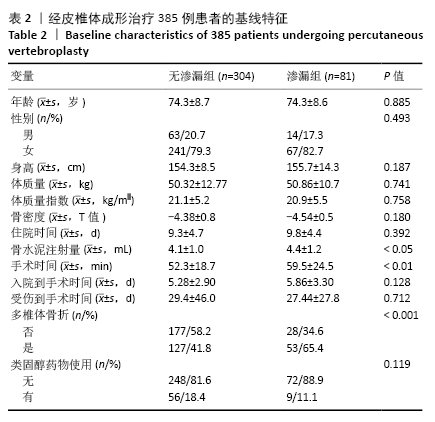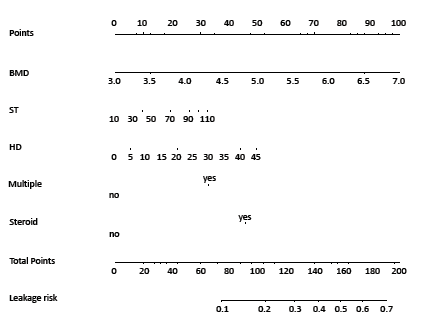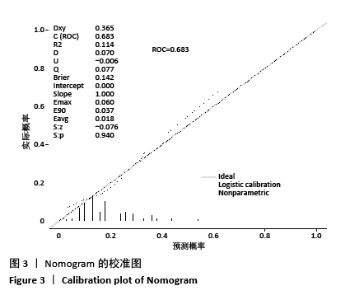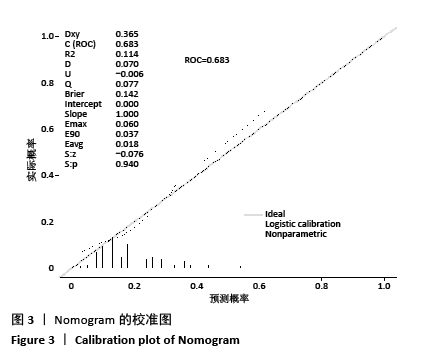Chinese Journal of Tissue Engineering Research ›› 2022, Vol. 26 ›› Issue (10): 1477-1482.doi: 10.12307/2022.190
Analysis of the risk for bone cement leakage after percutaneous vertebroplasty in osteoporosis patients and model verification
Li Wenle1, 2, 3, Wang Haosheng4, Ning Lijun5, Zhang Wenshi6, Gao Sen7, Sun Lijun8, Hu Zhaohui3
- 1Clinical Medical Research Center, 2Department of Orthopedics, Xianyang Central Hospital, Xianyang 712000, Shaanxi Province, China
-
Received:2020-11-25Revised:2020-11-30Accepted:2020-12-31Online:2022-04-08Published:2021-10-25 -
Contact:Hu Zhaohui, MD, Professor, Chief physician, Department of Spinal Surgery, Liuzhou People’s Hospital, Liuzhou 545000, Guangxi Zhuang Autonomous Region, China -
About author:Li Wenle, Master, Physician, Researcher, Clinical Medical Research Center, Department of Orthopedics, Xianyang Central Hospital, Xianyang 712000, Shaanxi Province, China; Department of Spinal Surgery, Liuzhou People’s Hospital, Liuzhou 545000, Guangxi Zhuang Autonomous Region, China -
Supported by:the National Natural Science Foundation of China, No. 81260274 (to HZH); the Research and Development Program of Science and Technology in Liuzhou, No. 2014J030405 (to HZH)
CLC Number:
Cite this article
Li Wenle, Wang Haosheng, Ning Lijun, Zhang Wenshi, Gao Sen, Sun Lijun, Hu Zhaohui. Analysis of the risk for bone cement leakage after percutaneous vertebroplasty in osteoporosis patients and model verification[J]. Chinese Journal of Tissue Engineering Research, 2022, 26(10): 1477-1482.
share this article
Add to citation manager EndNote|Reference Manager|ProCite|BibTeX|RefWorks
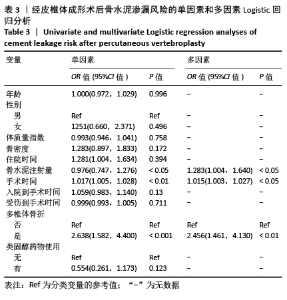
无渗漏组与渗漏组之间的年龄、性别、身高、体质量、体质量指数、骨密度、入院至手术时间、受伤至手术时间和类固醇药物使用比较差异无显著性意义(P > 0.05);无渗漏组骨水泥注射量低于渗漏组(P < 0.05),手术时间短于渗漏组 (P < 0.01),多椎体骨折比例低于渗漏组(P < 0.001)。 2.3 术后骨水泥的危险因素 Logistic回归分析结果见表3。单因素Logistic分析结果显示,骨水泥注射量、手术时长和是否多椎体骨折与术后骨水泥的危险因素有关(P均< 0.05)。OR值(优势比)显示了骨水泥渗漏的相对风险。 在多因素Logistic回归分析中,更高的骨水泥注射量[OR=1.283,95%CI(1.004,1.640),P < 0.05]、更长的手术时间[OR=1.0.15,95%CI(1.003,1.027),P < 0.05]以及多椎体骨折[OR=2.456,95%CI(1.461,4.130),P < 0.05]患者有更大的风险。因此,更高的骨水泥注射量、更长的手术时间、多椎体骨折是术后骨水泥渗漏的独立危险因素。 2.4 Nomogram的开发与验证 Nomogram是对Logistic回归分析结果进行量化和可视化的方法。根据表3的Logistic回归分析结果(P < 0.2)和既往文献筛选预测因子开发预测椎体成形术后骨水泥渗漏风险的Nomogram,见图2。"
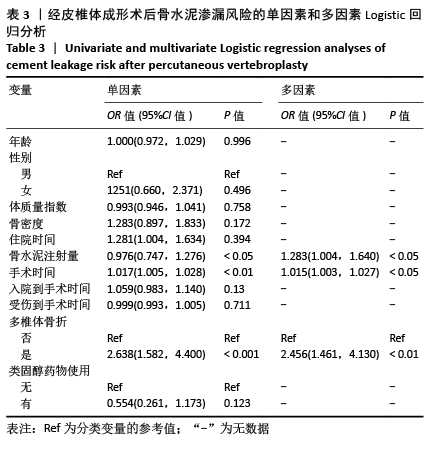
| [1] JOHNELL O, KANIS JA. An estimate of the worldwide prevalence and disability associated with osteoporotic fractures. Osteoporos Int. 2006; 17(12):1726. [2] LAVELLE W, CARL A, LAVELLE ED, et al. Vertebroplasty and Kyphoplasty. Med Clin North Am. 2007;25(2):913-928. [3] YANG EZ, XU JG, HUANG GZ, et al. Percutaneous Vertebroplasty Versus Conservative Treatment in Aged Patients With Acute Osteoporotic Vertebral Compression Fractures: A Prospective Randomized Controlled Clinical Study. Spine. 2016;41(8):653. [4] KLAZEN CA, LOHLE PN, DE VRIES J, et al. Vertebroplasty versus conservative treatment in acute osteoporotic vertebral compression fractures (Vertos II): an open-label randomised trial. Lancet. 2010; 376(9746):1085-1092. [5] CHANG W, ZHANG X, JIAO N, et al. Unilateral versus bilateral percutaneous kyphoplasty for osteoporotic vertebral compression fractures: A meta-analysis. Bone Joint J. 2014;96(17):e6738. [6] SCHMIDT R, CAKIR B, MATTES T, et al. Cement leakage during vertebroplasty: an underestimated problem? Eur Spine J. 2005;14(5): 466-473. [7] HULME PA, KREBS J, FERGUSON SJ, et al. Vertebroplasty and kyphoplasty: a systematic review of 69 clinical studies. Spine (Phila Pa 1976). 2006;31(17):1983-2001. [8] CLARK W, BIRD P, GONSKI P, et al. Safety and efficacy of vertebroplasty for acute painful osteoporotic fractures (VAPOUR): a multicentre, randomised, double-blind, placebo-controlled trial. Lancet (London, England). 2016;388(10052):1408-1416. [9] RHO YJ, CHOE WJ, CHUN YI. Risk factors predicting the new symptomatic vertebral compression fractures after percutaneous vertebroplasty or kyphoplasty. Eur Spine J. 2012;21(5):905-911. [10] CHEN Z, CHEN Z, WU Y, et al. Risk Factors of Secondary Vertebral Compression Fracture After Percutaneous Vertebroplasty or Kyphoplasty: A Retrospective Study of 650 Patients. Med Sci Monit. 2019;25:9255-9261. [11] LIN EP, EKHOLM S, HIWATASHI A, et al. Vertebroplasty: Cement Leakage into the Disc Increases the Risk of New Fracture of Adjacent Vertebral Body. AJNR Am J Neuroradiol. 2004;25(2):175-180. [12] AHN Y, LEE JH, LEE HY, et al. Predictive factors for subsequent vertebral fracture after percutaneous vertebroplasty. J Neurosurg Spine. 2008; (2):129-136. [13] CHEN WJ, KAO YH, YANG SC, et al. Impact of cement leakage into disks on the development of adjacent vertebral compression fractures. N Engl J Med. 2010;23(1):35-39. [14] XIE W, JIN D, MA H, et al. Cement Leakage in Percutaneous Vertebral Augmentation for Osteoporotic Vertebral Compression Fractures: Analysis of Risk Factors. Clin Spine Surg. 2016;29(4):E171. [15] NIEUWENHUIJSE MJ, PUTTER H, VAN ERKEL AR, et al. New vertebral fractures after percutaneous vertebroplasty for painful osteoporotic vertebral compression fractures: a clustered analysis and the relevance of intradiskal cement leakage. Radiology. 2013;266(3):862-870. [16] LEE DG, PARK CK, PARK CJ, et al. Analysis of Risk Factors Causing New Symptomatic Vertebral Compression Fractures After Percutaneous Vertebroplasty for Painful Osteoporotic Vertebral Compression Fractures. J Spinal Disord Tech. 2015;28(10):E578. [17] PARK SY. Nomogram: An analogue tool to deliver digital knowledge. J Thorac Cardiovasc Surg. 2018;155(4):1793. [18] GALIBERT P, DERAMOND H, ROSAT P, et al. Preliminary note on the treatment of vertebral angioma by percutaneous acrylic vertebroplasty. Neurochirurgie. 1987;33(2):166-168. [19] FILIPPIADIS DK, MARCIA S, MASALA S, et al. Percutaneous Vertebroplasty and Kyphoplasty: Current Status, New Developments and Old Controversies. Cardiovasc Intervent Radiol. 2017;40(12): 1815-1823. [20] BUCHBINDER R, KALLMES DF, JARVIK JG, et al. Conduct and reporting of a vertebroplasty trial warrants critical examination. Evid Based Med. 2017;22(3):106-107. [21] VOORMOLEN MH, LOHLE PN, JUTTMANN JR, et al. The risk of new osteoporotic vertebral compression fractures in the year after percutaneous vertebroplasty. J Vasc Interv Radiol. 2006;17(1):71-76. [22] HAN S, JANG IT. Analysis of Adjacent Fractures after Two-Level Percutaneous Vertebroplasty: Is the Intervening Vertebral Body Prone to Re-fracture? Asian Spine J. 2018;12(3):524-532. [23] CAROLINE AHK. Vertebroplasty versus conservative treatment in acute osteoporotic vertebral compression fractures (Vertos II): an open-label randomised trial. Lancet (London, England). 2010;9746:376. [24] HARRINGTON KD. Major neurological complications following percutaneous vertebroplasty with polymethylmethacrylate : a case report. J Bone Joint Surg Am. 2001;84(7):1070-1073. [25] REN HL, JIANG JM, CHEN JT, et al. Risk factors of new symptomatic vertebral compression fractures in osteoporotic patients undergone percutaneous vertebroplasty. Eur Spine J. 2015;24(4):750-758. [26] FU Z, HU X, WU Y, et al. Is There a Dose–Response Relationship of Cement Volume With Cement Leakage and Pain Relief After Vertebroplasty? Dose Response. 2016;14(4):1559325816682867. [27] ZHAN Y, JIANG J, LIAO H, et al. Risk Factors for Cement Leakage After Vertebroplasty or Kyphoplasty: A Meta-Analysis of Published Evidence. World Neurosurgery. 2017;101:633-642. [28] ZHU SY, ZHONG ZM, WU Q, et al. Risk factors for bone cement leakage in percutaneous vertebroplasty: a retrospective study of four hundred and eighty five patients. Int Orthop. 2016;40(6):1205-1210. [29] HA KY, LEE JS, KIM KW, et al. Percutaneous vertebroplasty for vertebral compression fractures with and without intravertebral clefts. J Bone Joint Surg Br. 2006;88(5):629-633. [30] LIU Q, CAO J, KONG JJ. Clinical effect of balloon kyphoplasty in elderly patients with multiple osteoporotic vertebral fracture. Niger J Clin Pract. 2019;22(3):289-292. [31] CHUNG SM, MOON JS, YOON JS, et al. Novel Nomogram for Screening the Risk of Developing Diabetes in a Korean Population. Diabetes Res Clin Pract. 2018;142:286-293. [32] VEALE D, MILES S, BRAMLEY S, et al. Am I normal? A systematic review and construction of nomograms for flaccid and erect penis length and circumference in up to 15,521 men. BJU Int. 2015;115(6): 978-986. |
| [1] | Lu Hui, Wu Qimei, Liu Rong. Finite element analysis and application of unilateral and bilateral bone-filling mesh container in treatment of osteoporotic vertebral compression fracture [J]. Chinese Journal of Tissue Engineering Research, 2023, 27(3): 391-397. |
| [2] | Wu Liang, Wang Qiang, Wang Wenbo, Xin Tianwen, Xi Kun, Tang Jincheng, Xu Jingzhi, Chen Liang, Gu Yong. Risk factors for traumatic central cord syndrome underlying with cervical spondylotic myelopathy [J]. Chinese Journal of Tissue Engineering Research, 2022, 26(9): 1388-1394. |
| [3] | Jiang Huanchang, Zhang Zhaofei, Liang De, Jiang Xiaobing, Yang Xiaodong, Liu Zhixiang. Comparison of advantages between unilateral multidirectional curved and straight vertebroplasty in the treatment of thoracolumbar osteoporotic vertebral compression fracture [J]. Chinese Journal of Tissue Engineering Research, 2022, 26(9): 1407-1411. |
| [4] | Yu Chengxiang, Liu Lehong, Li Wenbo, Chen Jinshi, Ran Chunlei, Wang Zhongping. Correlation between spine-pelvic sagittal parameters and prognosis of vertebroplasty in the treatment of thoracolumbar osteoporotic vertebral compression fractures [J]. Chinese Journal of Tissue Engineering Research, 2022, 26(9): 1412-1417. |
| [5] | He Shiping, Jia Dazhou, Li Xiaolei, Wang Qiang. Establishment of prediction model of blood transfusion after proximal femoral nail anti-rotation fixation of femoral intertrochanteric fracture in elderly adults [J]. Chinese Journal of Tissue Engineering Research, 2022, 26(6): 929-933. |
| [6] | Wang Zhiqiang, Lin Lu, Chen Xiaolin, Ke Zhenyong. Percutaneous vertebral augmentation for osteoporotic vertebral compression fractures: navigation, fracture reduction system, bone cement leakage, and material modification [J]. Chinese Journal of Tissue Engineering Research, 2022, 26(4): 631-636. |
| [7] | Ou Liang, Kong Dezhong, Xu Daoqing, Ni Jing, Fu Xingqian, Huang Weichen. Comparative clinical efficacy of polymethyl methacrylate and self-solidifying calcium phosphate cement in vertebroplasty: a meta-analysis [J]. Chinese Journal of Tissue Engineering Research, 2022, 26(4): 649-656. |
| [8] | Shen Song, Xu Bin. Diffuse distribution of bone cement in percutaneous vertebroplasty reduces the incidence of refracture of adjacent vertebral bodies [J]. Chinese Journal of Tissue Engineering Research, 2022, 26(4): 499-503. |
| [9] | Hou Wanxing, Li Hongwei, Zheng Xin, Zhu Xianren. Correlation between preoperative magnetic resonance imaging findings and bone cement leakage after percutaneous vertebral augmentation [J]. Chinese Journal of Tissue Engineering Research, 2022, 26(4): 504-509. |
| [10] | Huang Taosheng, Chen Jianquan, Lin Xinyuan, Lyu Zhouming, Chen Maoshui. 3D printing percutaneous puncture guide plate assisted vertebroplasty for single-level osteoporotic vertebral compression fracture with active registration location combined with anatomic marker localization [J]. Chinese Journal of Tissue Engineering Research, 2022, 26(36): 5819-5825. |
| [11] | Ma Qiaoqiao, Wu Zerui, Guo Zhuotao, Zhang Kai, Zha Guochun, Guo Kaijin. Absence of a tourniquet during total knee arthroplasty: a prospective randomized controlled trial [J]. Chinese Journal of Tissue Engineering Research, 2022, 26(36): 5831-5836. |
| [12] | Zhai Xiao, Yang Xinming, Liu Fanghong, Sun Jianwei. Effect of teriparatide combined with risedronate sodium on bone metabolism in patients with osteoporotic vertebral compression fractures [J]. Chinese Journal of Tissue Engineering Research, 2022, 26(35): 5685-5692. |
| [13] | Liu Jin, Yin Hongkun, Chen Guo, Zhang Yu, Gu Zuchao, Tang Jing. A machine learning prediction model based on MRI radiomics for refracture of thoracolumbar segments [J]. Chinese Journal of Tissue Engineering Research, 2022, 26(33): 5323-5328. |
| [14] | Shen Lianwei, Wang Wei. Construction of a nomogram model for predicting bone mass loss in middle-aged men [J]. Chinese Journal of Tissue Engineering Research, 2022, 26(32): 5085-5090. |
| [15] | Zhong Yuanming, He Bingkun, Wu Zhuotan, Wu Sixian, Wan Tong, Zhong Xifeng. Meta-analysis of efficacy and safety of Jack kyphoplasty for osteoporotic vertebral compression fractures [J]. Chinese Journal of Tissue Engineering Research, 2022, 26(3): 487-492. |
| Viewed | ||||||
|
Full text |
|
|||||
|
Abstract |
|
|||||

